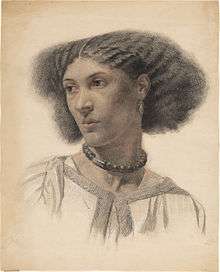Fanny Eaton
| Fanny Eaton | |
|---|---|
 Portrait by Walter Fryer Stocks, ca. 1859, Princeton University Art Museum | |
| Born |
Fanny Antwistle 23 June 1835 St. Andrew, Surrey, Jamaica |
| Died |
4 March 1924 (aged 88) Hammersmith and Fulham |
| Nationality | Jamaican, English |
| Occupation | Art model, domestic cook |
| Years active | 1859–67 (art model) |
| Known for | Pre-Raphaelite model |
Fanny Eaton (23 June 1835 – 4 March 1924) was a Jamaican-born artist's model and domestic worker. She is best known for her work as a model for the Pre-Raphaelite Brotherhood and their circle between 1859–67. Her public debut was in Simeon Solomon's The Mother of Moses, which was exhibited at the Royal Academy in 1860. She was also featured in works by Dante Gabriel Rossetti, John Everett Millais, Joanna Bryce Wells, Rebecca Solomon, and others.[1]
Early life and career
Eaton was born Fanny Antwistle or Entwhistle[2] on 23 June 1835 in St. Andrew, Jamaica. Her mother was Matilda Foster, a woman of African descent, who may have been born into slavery. No father was named on Eaton's birth records, suggesting that she may have been illegitimate.[3] Eaton and her mother made their way to England sometime in the 1840s. By 1851 she is recorded as living in London, with her mother, and working as a domestic servant. In 1857 she married James Eaton, a horse-cab proprietor and driver, who was born on 17 February 1838 in Shoreditch. Together they had 10 children.
Modelling
It was during this period of Fanny Eaton's life as mother and new wife that she began modelling for the Pre-Raphaelites. Eaton primarily modelled out of necessity; to augment her salary as a "charwoman" and provide sustenance for her 10 children. Her distinctive features were often used by artists to portray a variety of ethnicities and characters. The earliest studies done of her are pencil sketches by Simeon Solomon in 1859. These sketches were used as preparation for his Mother of Moses, now in the rich collection of the Delaware Art Museum. Two specific sketches from this series, depicted Mrs Eaton as the two Biblical figures of Jochabed and Miriam. The finished painting was shown at the Royal Academy in 1860. In 1865, she was used by Dante Gabriel Rossetti for the figure of the one of the bridesmaids in his painting The Beloved.[4] Jephthah seems to be the last painting featuring Eaton.
Impact
Although Eaton's modelling career for the Pre-Raphaelites seems to have been short, her impact has been undeniably intense. This impact is evident enough from the large body of work in which she features. In a letter to Ford Madox Brown, Rossetti praises Mrs. Eaton for her incomparable beauty and "very fine head", a not insignificant feat considering that the era is infamous for its rigid beauty standards and intense racial prejudices. Born in the British colonies and daughter of a former slave, Fanny Eaton's visual presence in artwork represented a social group outside of the traditional Victorian parameters. Her appearance in paintings and Pre-Raphaelite art focused attention onto the "Other" in Victorian society, challenging societal expectations of black women. Victorian art typically portrayed people of colour as decorative figures and they were rarely seen as models of idealized beauty.
In 2018, in celebration of the 100th anniversary of women's right to vote, The Voice newspaper listed Eaton – alongside Kathleen Wrasama, Olive Morris, Connie Mark, Diane Abbott, Lilian Bader, Margaret Busby, and Mary Seacole – among eight Black women who have contributed to the development of Britain.[5]
Death
By 1881 Eaton had been widowed and was working as a seamstress. In the final years of her life, Eaton worked as a domestic cook on the Isle of Wight for a Hammersmith-based wine merchant and his wife, John and Fanny Hall. By 1911, however, Fanny is said to be residing with family in Hammersmith Fulham with her daughter Julia, son-in-law Thomas Powell and grandchildren Baden and Connie Powell. After a long life as a working-class émigrée, Fanny Antwisle Eaton died in Acton on 4 March 1924 at the age of 89 from senility and syncope.
References
- ↑ Ferrari, Roberto C., 2014, "Fanny Eaton: The 'Other' Pre-Raphaelite Model", Columbia University Academic Commons, doi:10.7916/D8X92900.
- ↑ Marsh, Jan (2013). "Pictured at Work: Employment in Art 1800-1900". In Adi, Hakim; Bressey, Caroline. Belonging in Europe - The African Diaspora and Work. Routledge. ISBN 9781317989769.
- ↑ Giles, Laura M. "New Acquisition: Walter Fryer Stocks's Mrs. Fanny Eaton". Princeton University Art Museum.
- ↑ Marsh, Jan; Manchester City Art Gallery (2005). Black Victorians: black people in British art 1800-1900. Lund Humphries. ISBN 0853319308.
- ↑ Leah Sinclair, "Suffrage 100: The Black Women Who Changed British History", The Voice, 6 February 2018.